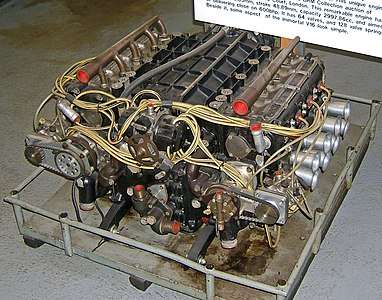BRM P75
The BRM P75 was a H16 engine developed by BRM, the engine was used in Formula One from 1966 to 1968.
| BRM P75 | |
|---|---|
 | |
| Overview | |
| Manufacturer | BRM |
| Production | 1966-1968 |
| Layout | |
| Configuration | H16 |
| Displacement | 3.0 L (2,996 cc) |
| Combustion | |
| Fuel system | Fuel injection |
| Fuel type | Gasoline |
| Cooling system | Water-cooled |
| Output | |
| Power output | 1966: 390 bhp (291 kW; 395 PS) 1967: 420 bhp (313 kW; 426 PS) |
| Chronology | |
| Predecessor | P56/P60 |
| Successor | P101 |
Background
Rules changes
In 1965, the Fédération Internationale de l'Automobile, that administered Formula One racing, agreed to raise the series' maximum engine capacity from 1.5 litres (92 cu in) to 3.0 litres (183 cu in) from 1966. Up until that point, BRM was challenging at the top with Lotus, Cooper and Ferrari.
Development
BRM decided to hedge their bets by developing their existing 16 valve 1.5 litre V8 into a 32 valve 3 litre H16 (effectively two flat 8s one on top of the other and geared together) while also developing a new 48 valve 3 litre V12 in partnership with Harry Weslake and opt for whichever turned out to be the better powerplant. After much debate Sir Alfred Owen decided BRM would go with the H16 and Weslake bought out BRM's involvement in the V12 and produced the engine that went on to power the Eagle T1G. The H16's development was complicated by BRM's involvement in two further V12 designs and a 4.2 litre version of the H16 for Lotus to use at the 1966 Indianapolis 500.[1]
Reliability
Various crankshaft vibration problems dogged the engine from the start, and to compound matters quick-fix balancing weights attached to the crankshafts developed the unfortunate habit of detaching themselves and flying off within the engines causing several catastrophic engine failures. Each side of the engine had to have its own water radiator, fuel metering unit, distributor and water pump, with a common oil radiator.[2] The first sign of trouble with the H16 came when the new engine arrived at the Team Lotus factory in Hethel, Norfolk and it required four men to lift it from the BRM truck to get into the Lotus factory. The sheer complexity of the engine led to a truly terrible record of unreliability with engine, transmission and related problems caused 27 of the powerplant's 30 retirements from 40 races.[3][4] The initial 32 valve engine produced 395hp at 10,250 RPM, with a later 64 valve variant raising this to 420hp at 10,500 RPM. While these constituted reasonable figures compared to the Ferrari, Honda and Weslake V12s and the Cosworth V8 of 1967, the H16 had an extremely narrow power band and was by some distance the heaviest engine on the grid, starting out weighing 555lb when introduced in 1966 with the final lightweight version lowering this to 398lb.
Formula One World Championship results
(key) (Races in bold indicate pole position) (Races in italics indicate fastest lap)
| Year | Entrant | Chassis | Tyre | Drivers | 1 | 2 | 3 | 4 | 5 | 6 | 7 | 8 | 9 | 10 | 11 | 12 | Points | WCC |
|---|---|---|---|---|---|---|---|---|---|---|---|---|---|---|---|---|---|---|
| 1966 | Owen Racing Organisation | BRM P83 | D | MON | BEL | FRA | GBR | NED | GER | ITA | USA | MEX | 22 | 4th | ||||
| Jackie Stewart | PO | PO | Ret | Ret | Ret | |||||||||||||
| Graham Hill | PO | PO | Ret | Ret | Ret | |||||||||||||
| Team Lotus | Lotus 43 | F | Peter Arundell | DNS | Ret | 13 | 5th | |||||||||||
| Jim Clark | Ret | 1 | Ret | |||||||||||||||
| 1967 | Owen Racing Organisation | BRM P83 | G | RSA | MON | NED | BEL | FRA | GBR | GER | CAN | ITA | USA | MEX | 17 | 6th | ||
| Mike Spence | Ret | 6 | 8 | 5 | Ret | Ret | Ret | 5 | 5 | Ret | 5 | |||||||
| Jackie Stewart | Ret | Ret | 2 | Ret | ||||||||||||||
| BRM P115 | Ret | Ret | Ret | Ret | Ret | |||||||||||||
| Reg Parnell Racing | BRM P83 | G | Chris Irwin | 5 | PO | 9 | Ret | Ret | Ret | Ret | ||||||||
| Team Lotus | Lotus 43 | F | Jim Clark | Ret | 6 | 8th | ||||||||||||
| Graham Hill | Ret | |||||||||||||||||
| 1968 | Owen Racing Organisation | BRM P115 | G | RSA | ESP | MON | BEL | NED | FRA | GBR | GER | ITA | CAN | USA | MEX | 28 | 5th | |
| Mike Spence | Ret | |||||||||||||||||
References
- "Yorkshire Ferret". yorkshireferret.blogspot.pt. Retrieved 16 March 2017.
- "July 1967 : Prototype Parade - Talking around the H16 B.R.M. unit". Vsrnonline.com. Archived from the original on 22 December 2010. Retrieved 29 October 2013.
- "Participations - BRM P75". FORIX. Retrieved 24 January 2016.
- Stewart, Jackie, Winning Is Not Enough, Headline Publishing Group, 2007, Page 176.